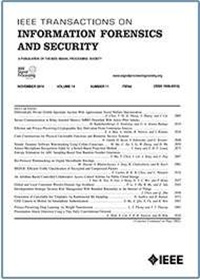区块链网络分区攻击与比特币和以太坊新防御
IF 8
1区 计算机科学
Q1 COMPUTER SCIENCE, THEORY & METHODS
IEEE Transactions on Information Forensics and Security
Pub Date : 2025-07-02
DOI:10.1109/TIFS.2025.3585468
引用次数: 0
摘要
加密货币和无许可区块链允许来自世界各地的节点加入,它们的快速发展创造了巨大的区块链网络,节点遍布全球。区块链网络分区攻击通过破坏通信,将网络分裂为独立的节点组,造成信息不一致,便于双重花费、自私挖矿等恶意行为,威胁区块链的安全性。现有研究主要研究具体的分区攻击方法。然而,很难分析攻击后对区块链安全和效率的实际影响,并设计有效的对策。本文研究了实际网络分区攻击对现有基于工作量证明(比特币)和基于权益证明(以太坊)的无权限区块链的影响。我们从理论上分析和实验上证实了网络分区对区块链性能和安全性的不利影响。网络分区会导致区块链吞吐量急剧下降,导致块生成延迟迅速增加。在我们对以太坊2.0的实验中,当分区网络之间的带宽低于768 Kbps时,吞吐量开始急剧下降,直到最终降至0。更糟糕的是,网络分区将显著提高双重花费的成功率。在我们对比特币的实验中,当分区网络之间的带宽小于256kbps时,双重支付的成功率达到50%。为了解决上述问题,我们提出了利用冻结阈值来保障无权限区块链的安全并抵御双重支出攻击的对策。我们通过实验验证了这些对策增强了无权限区块链对网络分区攻击的抵抗力。它减少了在分区网络中出现双重花费的可能性,从而保证了安全性和可靠性。本文章由计算机程序翻译,如有差异,请以英文原文为准。
Dissecting Blockchain Network Partitioning Attacks and Novel Defense for Bitcoin and Ethereum
Cryptocurrencies and permissionless blockchains allow nodes from all over the world to join, and their rapid development has created enormous blockchain networks with nodes spanning the globe. Blockchain network partitioning attacks split the network into separate node groups through disrupting communication, causing information inconsistency, and facilitating malicious behaviors like double-spending and selfish mining, threatening the blockchain security. Existing research primarily studies concrete partitioning attack methods. However, it is hard to analyze practical post-attack security and efficiency impacts on blockchains and design effective countermeasures. This paper studies practical network partitioning attacks’ impacts on existing proof-of-work-based (Bitcoin) and proof-of-stake-based (Ethereum) permissionless blockchains. We theoretically analyze and experimentally confirm the adverse effects of network partitioning on blockchain performance and security. Network partitioning will cause blockchain throughput to plummet, and cause block generation delay to increase rapidly. In our experiments on Ethereum 2.0, when the bandwidth between the partitioned networks is lower than 768 Kbps, the throughput begins to plummet precipitously until it ultimately falls to 0. What’s worse, network partitioning will significantly increase the success rate of double-spending. In our experiments on Bitcoin, when the bandwidth between the partitioned networks is less than 256 Kbps, the success rate of double-spending reaches 50%. To solve the above issues, we propose countermeasures leveraging a freezing threshold to safeguard the security of permissionless blockchains and resist double-spending attacks. We experimentally validate that the countermeasures enhance the resistance of permissionless blockchains to network partitioning attacks. It reduces the probability of double-spending in partitioned networks, thereby ensuring security and reliability.
求助全文
通过发布文献求助,成功后即可免费获取论文全文。
去求助
来源期刊

IEEE Transactions on Information Forensics and Security
工程技术-工程:电子与电气
CiteScore
14.40
自引率
7.40%
发文量
234
审稿时长
6.5 months
期刊介绍:
The IEEE Transactions on Information Forensics and Security covers the sciences, technologies, and applications relating to information forensics, information security, biometrics, surveillance and systems applications that incorporate these features
 求助内容:
求助内容: 应助结果提醒方式:
应助结果提醒方式:


